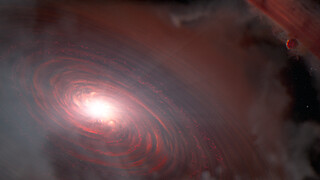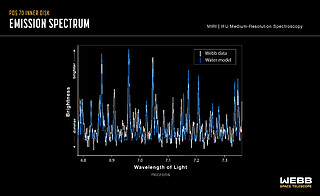weic2318 — Science Release
Webb detects water vapour in rocky planet-forming zone
24 July 2023
New measurements by the NASA/ESA/CSA James Webb Space Telescope’s Mid-InfraRed Instrument (MIRI) have detected water vapour in the inner disc of the system PDS 70, located 370 light-years away. This is the first detection of water in the terrestrial region of a disc already known to host two or more protoplanets.
Water is essential for life as we know it. However, scientists debate how it reached the Earth and whether the same processes could seed rocky exoplanets orbiting distant stars. New insights may come from the system PDS 70, which hosts an inner disc and an outer disc that are separated by a gap of eight billion kilometres, within which are two known gas-giant planets. MIRI has detected water vapour in the system’s inner disc at distances of less than 160 million kilometres from the star — the region where rocky, terrestrial planets may be forming (the Earth orbits 150 million kilometres from our Sun).
“We’ve seen water in other discs, but not so close in and in a system where planets are currently assembling. We couldn’t make this type of measurement before Webb,” said lead author Giulia Perotti of the Max Planck Institute for Astronomy (MPIA) in Heidelberg, Germany.
“This discovery is extremely exciting, as it probes the region where rocky planets similar to Earth typically form,” added MPIA director Thomas Henning, a co-author of the paper. Henning is co-principal investigator of Webb’s MIRI (Mid-InfraRed Instrument), which made the detection, and the principal investigator of the MINDS (MIRI Mid-Infrared Disk Survey) programme that took the data.
A wet environment for forming planets
PDS 70 is a K-type star, cooler than our Sun, and is estimated to be 5.4 million years old. This is relatively old amongst stars with planet-forming discs, which made the discovery of water vapour surprising.
Over time, the gas and dust content of planet-forming discs declines. Either the central star’s radiation and winds remove such material, or the dust grows into larger objects that eventually form planets. As previous studies failed to detect water in the central regions of similarly aged discs, astronomers suspected it might not survive the harsh stellar radiation, leading to a dry environment for the formation of any rocky planets.
Astronomers haven’t yet detected any planets forming within the inner disc of PDS 70. However, they do see the raw materials for building rocky worlds, in the form of silicates. The detection of water vapour implies that if rocky planets are forming there, they will have water available to them from the beginning.
“We find a relatively large amount of small dust grains. Combined with our detection of water vapour, the inner disc is a very exciting place,” said co-author Rens Waters of Radboud University in the Netherlands.
What is the origin of the water?
The discovery raises the question of where the water came from. The MINDS team considered two different scenarios to explain their finding.
One possibility is that water molecules are forming in place, where we detect them, as hydrogen and oxygen atoms combine. A second possibility is that ice-coated dust particles are being transported from the cool outer disc to the hot inner disc, where the water ice sublimates and turns into vapour. Such a transport system would be surprising, since the dust would have to cross the large gap carved out by the two giant planets.
Another question raised by the discovery is how water could survive so close to the star, where the star’s ultraviolet light should break apart any water molecules. Most likely, surrounding material, such as dust and other water molecules, serves as a protective shield. As a result, the water detected near PDS 70 could survive destruction.
Ultimately, the team will use two of Webb’s other instruments, the Near-InfraRed Camera (NIRCam) and the Near-InfraRed Spectrograph (NIRSpec) to study the PDS 70 system in an effort to glean an even greater understanding.
These observations were made as part of Guaranteed Time Observation program 1282. This finding has been published in the journal Nature.
More information
Webb is the largest, most powerful telescope ever launched into space. Under an international collaboration agreement, ESA provided the telescope’s launch service, using the Ariane 5 launch vehicle. Working with partners, ESA was responsible for the development and qualification of Ariane 5 adaptations for the Webb mission and for the procurement of the launch service by Arianespace. ESA also provided the workhorse spectrograph NIRSpec and 50% of the mid-infrared instrument MIRI, which was designed and built by a consortium of nationally funded European Institutes (The MIRI European Consortium) in partnership with JPL and the University of Arizona.
Webb is an international partnership between NASA, ESA and the Canadian Space Agency (CSA).
Links
- Collection of Webb’s First Images
- ESA Webb Seeing Farther Interactive Brochure
- Release on ESA website
- Release on STScI website
- Release on NASA website
- Science paper
Contacts
Markus Nielbock
Max Planck Institute for Astronomy, Heidelberg, Germany
Email: [email protected]
Bethany Downer
ESA/Webb Chief Science Communications Officer
Email: [email protected]
Ninja Menning
ESA Newsroom and Media Relations Office
Email: [email protected]
About the Release
| Release No.: | weic2318 | |
|---|---|---|




